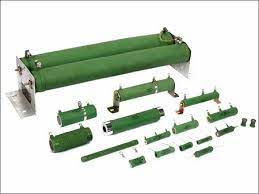| types of resistors |
ResistorsThe property of a material that resists the flow of electric charge is called Resistors. The SI unit of resistance is the ohm, represented by the Greek symbol “Ω”. Every material, regardless of its shape or size, possesses some inherent resistance.

In some materials, the resistance is uniformly distributed throughout the entire body, while in others — especially impure materials or those with non-uniform composition — the resistance may vary from point to point.
The resistance of a material depends on the following characteristics:
- Resistivity of the material
Resistivity is an intrinsic property that quantifies how strongly a given material opposes the flow of electric current. Materials like copper and silver have low resistivity and are good conductors, while materials like rubber have high resistivity. - Length of the material
Resistance is directly proportional to the length of the conductor. A longer conductor offers more resistance to the flow of current. - Cross-sectional area of the material
Resistance is inversely proportional to the cross-sectional area. A thicker conductor has less resistance, as it provides more space for the current to flow.
Hence, if the resistance is measured between two different faces of a rectangular solid material, the measured resistance can vary depending on which faces are used. This is due to the variation in path length and cross-sectional area.
In electronic circuits, specific resistance values are often required for accurate and stable operation. These specific values are not always naturally available. Therefore, using mechanical methods, resistive materials are processed and shaped to form resistors of desired values suitable for use in circuits.
Resistors used in electronic circuits can be of two main types:
- Fixed Resistors:
These have a constant resistance value that cannot be changed. They are widely used for setting biasing levels, current limiting, and voltage division. - Variable Resistors:
Also known as potentiometers or rheostats, these allow for manual adjustment of resistance in a circuit. They are used where tuning or calibration is required.
🧮 Resistance Calculation Formula:
The resistance of a conductor can be calculated using the formula:
R=ρLAR = \rho \frac{L}{A}R=ρAL
Where:
- R= Resistance (in Ohms, Ω)
- ρ\rhoρ = Resistivity of the material (Ohm-meter, Ω·m)
- L = Length of the conductor (in meters)
- A = Cross-sectional area of the conductor (in square meters)
This shows that resistance increases with length and decreases with thickness of the conductor.
⚡ Ohm’s Law:
Another commonly used formula is Ohm’s Law:
V=I R
Where:
- V = Voltage (in Volts)
- I = Current (in Amperes)
- R = Resistance (in Ohms)
This formula helps determine how much current flows through a circuit for a given voltage and resistance.
🔌 Real-World Applications of Resistors:
| Application Area | Role of the Resistor | ||
| Ceiling fan regulator | Used as a variable resistor to control fan speed | ||
| Mobile phone charger | Contains fixed resistors to control voltage and protect components | ||








